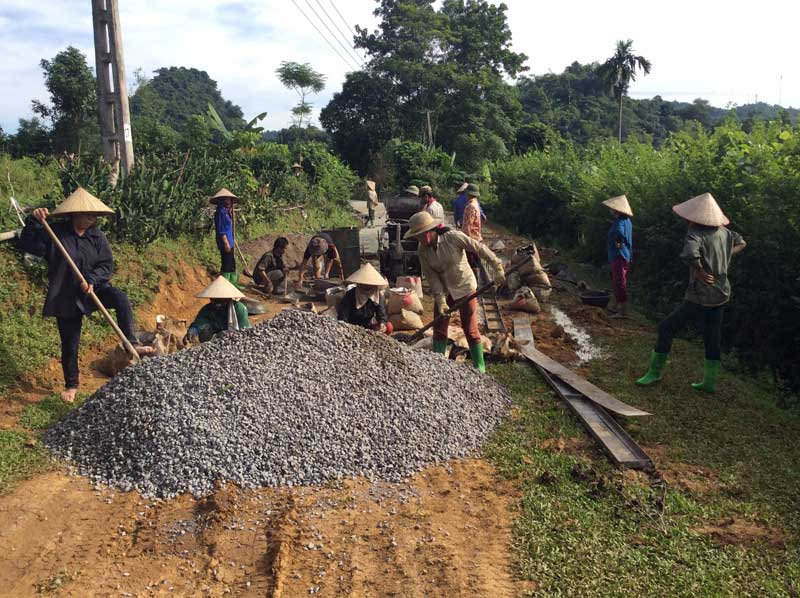
(HBO) – Preserving traditional cultural values has formed the basic foundation for Dich Giao commune, a locality inhabited by Muong ethnic people and located in the centre of Muong Bi region, to successfully develop a standout new style rural area model in Tan Lac district.
Dich Giao commune was recognised as a new style rural area in June 2015. Local
Party, authorities and people have continued their efforts to mobilise social
resources to improve its realised criteria. The commune has upgraded and
expanded many rural roads in accordance with set criteria. Roads running
through Khang, Sung 2 and Sung 3 hamlets were enlarged to 3.5 metres in width.

Photo:
Locals in Khang hamlet, Dich Giao commune involve in road construction
The commune has paid due attention to ensuring rural environment. Along
with signing commitments with the authorities to protect the environment in
production and breeding, local people have maintained road clean-ups to ensure
public health. Responsibilities of local individuals are concretised in each
hamlet’s regulations. Accordingly, local residents voluntarily clean up rural
roads in every Saturday.
Bui Van Dinh, Chairman of the Dich Giao commune People’s Committee, said: "The
commune’s success in implementing the national programme on building new style
rural areas is spurred by the consensus of local officials and Party members
who have set good examples and played pioneering roles in the mission”.
Notably, Dich Giao has prioritised the preservation of traditional cultural
values. Despite the changing life, it is still common to see traditional
costumes to be worn by local people or hear stories and greetings in ethnic
languages. It becomes the ideology of local people in the new style area
building process.
During the construction of rural infrastructure, more than 700 households
donated their lands. Among families giving hundreds of metres of land are Bui
Van Hau’s family in La hamlet and Bui Thi Thoan’s family in Sung 1 hamlet.
Currently, 11 out of 14 hamlets in the commune are cultural villages and more
than 85 percent of households are recognised as cultural families./.
With just over a month left until the school summer break, students are eagerly anticipating a period of rest and fun after a year of academic pressure. To provide a healthy environment for the physical development, in addition to the classes that foster talents and enhance the academic knowledge, sports and physical activities continue to attract a large number of children and teenagers.
On April 17th, Hoa Binh Provincial Museum organized a program to promote and introduce the outstanding values of "Hoa Binh Culture” at the Boarding Secondary and High School for ethnic minority students in Mai Chau District.
The Hoa Binh College of Technical Technology, in collaboration with the Hoa Binh Technical and Economic College and the provincial Association of Literature and Arts, hosted a gathering on April 15 to celebrate Laos’ traditional Bunpimay (New Year) Festival 2025 and debut the new book "Nguoi Muong o ban Don” (Muong people in Don village).
In the millennia-long history of national construction and safeguarding, people of all ethnic groups in Hoa Binh have been united and closely bound together to overcome all difficulties and challenges, standing alongside the entire Vietnamese people throughout the history of building and defending the country.
Living green is a healthy, positive, and sustainable lifestyle that not only helps protect
the environment and quality of life but also conserves natural resources and ecosystems.
Among the many ways to embrace this lifestyle, reducing plastic consumption is one of the most impactful.
The women's unions at all levels in Kim Boi district have been making significant contributions to the movement of building cultural life in the local community.
The movement helps improve rural look and the spiritual and material lives of local residents.



